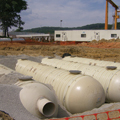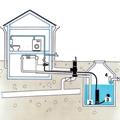As fresh water dwindles, you can take steps to save natural resources.

From a global perspective, fresh water is becoming an increasingly precious resource. By some estimates, as many as 3.4 billion people around the world will lack adequate and safe fresh water.
It is still easy to take water’s availability for granted here in the United States. However, increasing population, corruption of water by industrial and agricultural activity, steadily receding sources and climate changes conspire to reduce water availability and increase water cost. As a result, “water politics” have come closer to the forefront of public consciousness as people see their water bills rise to a significant household expense, while cities and towns manage aging distribution piping, and utilities seek out water supplies that are increasingly harder to reach.
The challenges related to water conservation and efficiency have become a significant factor in plumbing system design going back to the 1990s when low-consumption fixtures became mandated by law. Since then, further incentives for water use reduction have been established through the U.S. Green Building Council’s Leadership in Energy and Environmental Design building certification system. Beyond low-consumption fixture prerequisites for LEED certification, water use reduction credits toward certification are commonly achieved through the collection of rainwater as an alternative source of fresh water.
Rainwater harvesting is a method of collecting rainwater from the roofs of buildings or other catchment surfaces and sending it to storage for future use. Although rainwater is essentially purified water from the sky (i.e., condensed water vapor), when it hits the catchment surface and flows into drainage pipes, certain contaminants will be carried along. Reducing these contaminants is the key to maintaining good water quality for its use as irrigation water, fixture flushing water and, in some cases, drinking water for homes.
In any rainwater harvesting application, it has been long understood that the quality of the water stored for re-use starts with the treatment of rainwater before it’s collected in the cistern. Other necessary steps and techniques in the collection and storage process also are important. The manner in which rainwater shedding from a catchment surface is handled is a critical first step in managing stored water quality, while other methods in handling the water further ensure good quality. The central factor in any efficient and quality system is the health of the water in the cistern.
Stored water quality
Contaminants swept along with rain include dirt, leaves and other deposited foliage, pollen, insects and wildlife deposits. If these items were to be simply deposited in a cistern and left to sit, the turbidity of the water and the general “health” of the water would degrade. Without proper care in a rainwater harvesting system’s design, water in a cistern can easily degrade to the point of being unusable. Unfortunately, many designers inexperienced in proper rainwater harvesting design accept this situation and try to make up for poor water quality with elaborate and unnecessary water-treatment equipment at the back end. However, a general overview of microbiology can help designers understand how certain water collection and handling methods exploit natural processes to maintain water quality and avoid conditions that lead to poor quality.

Aerobic consumption
Contaminants such as leaves, pollen, insects and wildlife deposits contribute what is referred to as biological oxygen demand. BOD is a measure of the organic content in water that serves as nutrients to microbial life in the water, which in turn consumes oxygen through metabolism. Water typically has a certain amount of oxygen dissolved in it. Oxygen, in combination with organic nutrients, supports aerobic microbial metabolism. That is, microbes that use oxygen for growth.
The primary byproduct of this metabolic process is carbon dioxide. The more organic nutrients present, the longer and faster aerobic microbes feed and multiply. These microbes develop at the upper part of the water in a tank where most oxygen is present. This aerobic process depletes the oxygen content in the water. In principle, this aerobic process is beneficial to water quality as it digests (biodegrades) the organic matter into carbon dioxide and inert matter. As long as oxygen is present to feed this metabolic process, the water will remain clean and healthy. It’s this process (in a more massive scale) that waste treatment plants use as one of the final steps to remove BOD. However, if the aerobic process continues to deplete oxygen in the water, less favorable conditions will develop.
Anaerobic decomposition
When oxygen is consumed faster than it can be replaced in the water, the aerobic metabolism process collapses and another microbial process flourishes. This process is called anaerobic microbial metabolism. That is, microbes that do not use oxygen for growth. Like aerobic digestion, this process produces carbon dioxide as a byproduct, but it also produces methane, ammonia, acids and hydrogen sulfide. With enough organic nutrients left over after the aerobic cycle has collapsed, the anaerobic cycle is left to take over.
The anaerobic process first develops at the bottom of a water storage tank where the amount of oxygen is the lowest. Although this metabolic process is used in waste treatment of sewage sludge and for production of renewable fuels, it is generally a process of decomposition that produces objectionable color and odor characteristic of stagnant water. Think swamp gas. Also, most intestinal pathogens are anaerobes. This anaerobic cycle in a cistern can be referred to as the water having “gone septic,” meaning an unhealthy condition of the water. Therefore, this cycle is to be minimized in cisterns and other water storage tanks.
There are four practical ways to promote the good, aerobic microbial process and discourage the bad, anaerobic microbial process in cisterns. First, the water needs to be oxygenated. This starts with encouraging the mixture of water with air when it is captured. Second, organic content of the water needs to be minimized through proper filtration of rainwater before it enters the cistern. That is, the aerobic process should be encouraged in the cistern to promote good quality, but it needs to be kept on a diet to avoid collapsing into anaerobic decomposition. Third, the good aerobic metabolic process needs to be encouraged through the development of a beneficial “biofilm” on the inner surface of the cistern. Fourth, debris will inevitably enter a cistern and the biofilm will be established. The proper depositing of water and withdrawal of water should avoid disturbing both sedimentation and biofilm.
Start with the cistern
All this microbiological theory sounds good, but what practical measures can designers employ in an effective and reliable rainwater harvesting system? If there is one central premise to be emphasized before further collection and storage methods are discussed, it’s that the heart of rainwater harvesting system health is within the cistern. It is within the cistern where nature will take its course either to promote good quality water or to degrade it. Proper collection and storage measures will promote good quality and reduce the burden on further treatment equipment prior to final use. These measures will be discussed in subsequent issues. These measures include self-cleansing mesh screens and first-flush devices to reduce organics in rainwater before introduction into the cistern; proper inlet designs; proper overflow, backflow and venting; and proper pump suction configurations.
All these measures help promote and sustain the aerobic process and discourage anaerobic microbial growth. Certain rainwater harvesting devices on the market are available to specifiers to design an effective rainwater harvesting system. What is most compelling about the methods mentioned above is that they are essentially passive. No moving parts need attention or intervention. Only a few parts need periodic cleaning and inspection.
In fact, a properly designed collection and storage system for rainwater harvesting will never require that the cistern interior be cleaned during its lifetime. Further, maintaining proper water quality in the cistern reduces the size, initial expense and operating expense of further water treatment measures, particularly filters. This is most important when well- meaning building developers face budget shortages.
The simpler the rainwater harvesting system design is, the less it will cost and it may be more likely to survive cost-cutting measures. From another perspective, more elaborate, expensive and mechanically driven treatment systems may consume more energy and resources than they are doing good through water conservation.
Part 2 of this series will discuss proper rainwater collection, first flush and filtration with vertical screen devices.